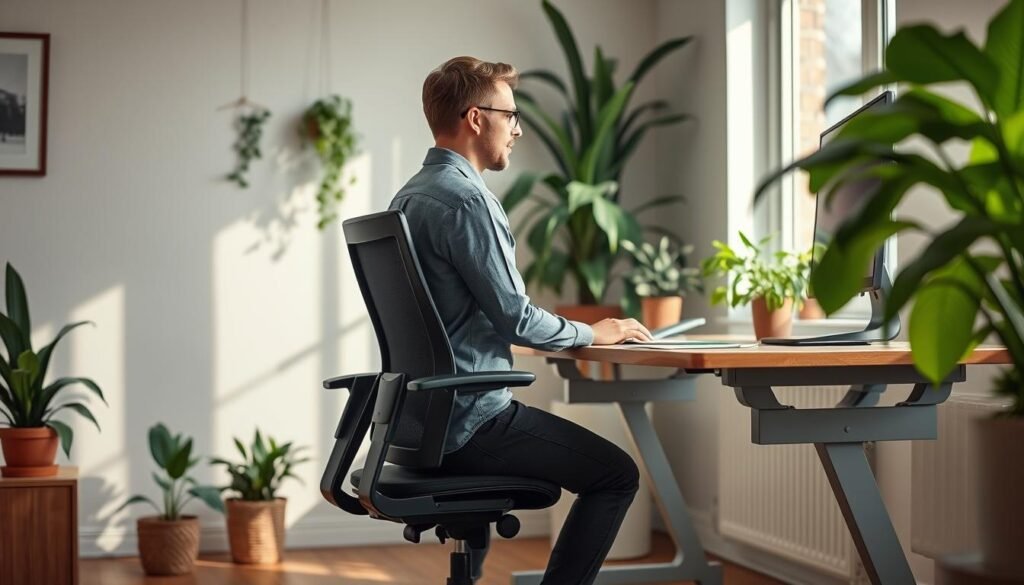Did you know nearly 80% of people will face back pain at some time? This fact highlights how common back pain is, driving many to seek medical guidance or miss work. It’s a leading cause of disability worldwide, greatly affecting people’s lives and well-being. What’s more, back pain often goes hand in hand with chronic fatigue. This combination creates a tough cycle to escape.
To manage pain effectively, it’s vital to understand the link between back pain and fatigue. This piece will explore the main causes of both, shedding light on their impact on health. We’ll give you the knowledge to fight these persistent problems. Adding flexibility exercises to your daily routine might help ease both issues. For deeper insights on how such exercises can lessen mental and physical fatigue, go to this resource.
Key Takeaways
- Back pain affects up to 80% of individuals during their lifetime.
- Fatigue is often exacerbated by chronic pain conditions.
- Flexibility exercises can enhance mobility and reduce fatigue.
- Common causes include muscle strains, arthritis, and poor posture.
- Incorporating ergonomic solutions can help prevent back pain.
Understanding Back Pain
Back pain affects all ages. It includes muscle aches, sharp pains, or burning feelings. These may spread to the legs. Movements like bending or lifting make it worse. Knowing about this condition helps in managing and easing its effects.
Definition of Back Pain
The definition of back pain differs from person to person. It is discomfort from the spine, muscles, or nearby areas. This pain ranges from mild to severe. Back pain is divided into acute and chronic, depending on how long it lasts.
Types of Back Pain
Understanding types of back pain aids in choosing treatments. Acute pain is short-term, caused by injuries or strains. Chronic pain lasts over three months, due to long-term issues. Age, lifestyle, and past injuries play roles. Addressing these can greatly improve life quality.
Exploring the Connection Between Back Pain and Fatigue
Back pain and fatigue are closely linked, troubling many people. Chronic back pain often leads to constant tiredness, impacting daily lives. The effort to deal with pain can disturb sleep and cause exhaustion. This repeating cycle can lower energy and make daily joys harder to find.
How Back Pain Leads to Fatigue
Chronic pain, if it lasts more than three months, can cause fatigue. Studies show that nearly half of those with chronic back pain feel very tired. This tiredness comes from poor sleep and the body’s fight against pain. Adding gentle exercises like walking or swimming can help decrease pain and tiredness.
Effects on Daily Life and Well-being
Back pain and fatigue can really affect daily life, especially activities that need physical effort or sharp thinking. Tiredness can lower work performance and harm personal connections. Mental health might also get worse when dealing with both back pain and fatigue. People often try diet changes or relaxation techniques to ease these issues.
Common Causes of Back Pain
Back pain affects many people, with eight out of ten Americans experiencing it. It can come from muscle strains, herniated disks, or arthritis, among other things. Knowing the common causes helps in managing the pain better.
Muscle Strains and Ligament Sprains
Heavy lifting or sudden moves can lead to muscle strains. This overstretches muscles, causing inflammation and pain. Sprains can add to the discomfort.
Using correct lifting methods and staying active lowers injury risks. It’s key to preventing strains and sprains.
Herniated Disks
Herniated disks happen when the spine’s cushion-like disks bulge or rupture. This may press on the nerves, causing pain or numbness that can spread to the legs.
Age-related wear and tear often causes this. Physical therapy helps, but surgery is an option if needed.
Arthritis and Degenerative Conditions
Arthritis often leads to chronic back pain, especially in older people. It results in joint pain and inflammation in the spine.
Conditions like spinal stenosis make the canal narrow. This can hurt and make legs weak. Staying active and getting medical advice is important for managing arthritis.
| Cause | Symptoms | Treatment Options |
|---|---|---|
| Muscle Strains | Pain during movement, muscle stiffness | Rest, ice application, physical therapy |
| Herniated Disks | Sharp pain, numbness in legs | Physical therapy, medication, surgery (if severe) |
| Arthritis | Joint pain, stiffness, inflammation | Medication, lifestyle changes, physical therapy |
Understanding Fatigue: Why It Occurs
Fatigue is a common issue that many people face. It comes in different forms, each linked to various causes. Understanding these can help manage fatigue better.
Types of Fatigue
Fatigue shows up in several ways:
- Physical Fatigue – You feel less energetic and more tired after working hard.
- Mental Fatigue – Happens after long periods of thinking, affecting your choices.
- Emotional Fatigue – Tied to stress and emotional struggles, it makes you feel swamped.
Various reasons cause different kinds of fatigue. Conditions like anemia and diabetes can cause physical tiredness. Mental health issues can increase overall fatigue.
How Fatigue Affects Physical Activity
Fatigue impacts how active we are. People with fatigue find it hard to exercise regularly. This is key for staying energetic. Conditions like chronic back pain can make fatigue worse. This leads to a vicious circle of less activity and more discomfort.
Exercise plays a big role in dealing with fatigue. Regular exercise can ease some fatigue types. Ignoring physical activity can make tiredness last longer. Making lifestyle changes like drinking enough water, handling stress well, and sleeping enough can help beat fatigue.

| Type of Fatigue | Characteristics | Common Causes |
|---|---|---|
| Physical Fatigue | Reduced energy, weakness | Anemia, chronic illness, overexertion |
| Mental Fatigue | Cognitive decline, lack of focus | Stress, anxiety, sleep disorders |
| Emotional Fatigue | Feelings of overwhelm, irritability | Emotional stress, depression |
Back Pain and Fatigue: Common Causes and Solutions
Back pain and fatigue are linked. This connection sheds light on how our minds and daily habits affect health. People with back pain often feel more tired. This makes their back pain worse. Changing specific habits and mindsets can make a big difference in feeling better daily.
Psychological Factors Influencing Pain and Fatigue
How we think and feel plays a big role in pain and tiredness. Stress, anxiety, and feeling down can make pain feel worse. It’s important to deal with these feelings. This can help lessen back pain and fatigue. Using mindfulness and relaxation can help change our mood. This might make pain feel less intense.
The Role of Lifestyle Choices
What we do every day matters for back pain and tiredness. Exercising can make painful episodes shorter. Yoga can help people with low back pain be more active. Eating healthy helps your general health. It can also make it easier to keep a healthy weight, reducing back strain. You might want to try these good habits:
- Incorporate regular physical activity to strengthen core muscles and improve posture.
- Practice proper lifting techniques to prevent back strain and injury.
- Ensure adequate sleep to help the body recover and manage fatigue.
- Consider alternative therapies such as acupuncture and massage to alleviate pain.
- Adopt a diet low in saturated fats and sugars to support weight management.
Mixing these good habits with understanding psychological factors makes a strong plan against back pain and fatigue. For more help, visit effective pain management methods. It’s important to look after both your body and mind.
| Lifestyle Choice | Benefit |
|---|---|
| Regular Exercise | Shorter and less frequent episodes of back pain |
| Yoga | Improved activity for individuals with low back pain |
| Proper Diet | Weight management, reducing strain on the back |
| Alternative Therapies | Pain relief and reduced stress through massage and acupuncture |
Effective Pain Management Strategies
Individuals experiencing back pain can significantly enhance their quality of life. They do this through effective pain management strategies. A mix of home remedies and physical therapy options often leads to relief and recovery.
Home Remedies for Relief
Home remedies are a good starting point for pain relief. These strategies include:
- Ice and heat applications: Cold compresses and heat pads reduce pain by easing inflammation and relaxing muscles.
- Over-the-counter medications: Ibuprofen and naproxen are common choices for managing back pain.
- Topical treatments: Creams and patches that deliver pain relief through the skin can target pain effectively.
- Gentle stretching exercises: Simple stretches promote flexibility and lessen muscle tension.
- Stress relief techniques: Meditation and mindfulness can reduce stress, which often contributes to chronic pain and fatigue.
Physical Therapy Options
For lingering back pain, physical therapy offers a structured way to recover. This includes:
- Targeted exercises: These exercises aim to strengthen muscles, boost flexibility, and improve posture to avoid future injuries.
- Education on body mechanics: Learning proper body mechanics can help prevent the return of back pain.
- Alternative treatments: Acupuncture, chiropractic care, and massage therapy can complement traditional treatments.
If home remedies fail to provide relief after a few weeks, consulting healthcare professionals is advised. They can tailor pain management plans that improve emotional health, relationships, and daily activities. This enables individuals to regain their quality of life. Regular exercise, customized to an individual’s needs, can greatly boost strength and energy levels. This shifts the focus from pain to living a full life.
| Home Remedies | Benefits |
|---|---|
| Ice application | Reduces inflammation and numbs pain |
| Heat therapy | Relaxes muscles and increases blood flow |
| Over-the-counter pain relievers | Addresses pain effectively |
| Physical therapy exercises | Enhances strength and flexibility |
| Stress management techniques | Helps mitigate chronic pain and fatigue |
Importance of Spinal Health
Understanding spinal health is key for feeling good overall. The spine is crucial in how our body functions. It sends nerve signals and allows movement. If we keep a healthy posture, we can avoid back pain. This means being mindful of how we sit and move every day.
Maintaining Healthy Posture
Keeping your posture right can help lessen spine stress. Here are ways to keep your spine happy:
- Keep the shoulders relaxed and aligned with the ears.
- Avoid slouching by strengthening the core muscles.
- Use ergonomic furniture to enhance spinal support.
Good posture helps prevent pain and tiredness. Check how you sit and stand often. It makes a big difference for your spine. For more tips, visit this resource.
Exercises to Strengthen the Back
Doing back exercises is great for your spine. They make your core strong and your spine flexible. Here are some exercises to try:
| Exercise | Description |
|---|---|
| Planks | Strengthens core muscles and improves stability. |
| Bridges | Targets glutes, hamstrings, and lower back for improved posture. |
| Cats and Cows | Promotes flexibility and mobility in the spine. |
| Bird-Dogs | Enhances balance and coordination by involving opposite limbs. |
Add these to your workout to keep your spine in shape. Exercise helps with blood flow and nerve health. Talk to a pro for advice tailored to you.
Ergonomics: Preventing Back Pain
Grasping ergonomics basics is vital to stave off back pain. This is especially true for those in desk jobs. A workplace with good ergonomics boosts productivity. It also cuts down on bodily stress.
Workplace Ergonomics
Sitting too long can really stress your back, neck, arms, and legs. Bad sitting postures often lead to back or neck pain. It’s important to sit right to stay healthy. Key points include:
- Ensuring a 90-degree angle for elbows
- Maintaining proper thigh alignment
- Providing good calf-chair distance
- Implementing lower-back support
- Aligning eye level with the computer screen
- Adjusting armrests properly
Following these tips can help lower work discomfort.
Ergonomic Equipment and Tools
Picking the right tools can make your workspace better. Traditional chairs support well, and kneeling chairs encourage good posture. Exercise balls help with core strength. You should stand, stretch, and walk a bit every 30 minutes to ease back pain.
Changing to a standing desk or adjusting your armrest also helps with sitting discomfort. Moving regularly and exercising can prevent back injuries. They keep you strong and flexible.

| Chair Type | Support Type | Benefits |
|---|---|---|
| Traditional Chair | Complete Support | Reduces back strain; comfortable for long periods |
| Kneeling Chair | Partial Support | Encourages good posture; less back strain |
| Exercise Ball | None | Strengthens core muscles; improves balance |
Using these ergonomic tools and tips leads to a healthier workplace. They play a big part in preventing back pain.
Building a Wellness Routine
A structured wellness routine is key to managing back pain and fatigue. It includes daily exercise and nutritional planning. This improves health and life quality.
Incorporating Exercise into Daily Life
Exercise every day is crucial for a healthy back and fighting fatigue. Walking, swimming, or biking are good because they don’t strain the body. Adding them regularly helps prevent back injuries.
- Engage in strength-training exercises targeting core muscles at least twice a week.
- Practice good posture to manage spinal health and reduce muscle strain.
- Vary workout routines to maintain interest and motivation.
- Schedule regular exercise sessions and allow for adequate rest to enhance recovery.
Nutritional Considerations for Pain and Fatigue Management
Nutrition affects your energy and body’s inflammation. Eating whole foods helps with pain and speeds up recovery. Making smart food choices gives your body the nutrients it needs.
| Food Group | Benefits for Pain and Fatigue |
|---|---|
| Fruits and Vegetables | Rich in antioxidants, helping reduce inflammation. |
| Lean Protein | Supports muscle repair and recovery. |
| Whole Grains | Provide sustained energy throughout the day. |
| Healthy Fats | Boosts brain function and decreases inflammation. |
When to Seek Medical Help
Back pain is quite common but often gets better over time. Still, there are moments when you need to act fast. Knowing when to get medical help is key. It could mean the difference between a quick recovery and dealing with something more serious. If you’re facing sharp, ongoing pain or alarming symptoms, it’s wise to see a doctor.
Signs That Require Medical Intervention
Not all back issues mean you should rush to the doctor. However, there are clear signs that you shouldn’t ignore:
- Pain that doesn’t go away after a week of home care.
- New problems with controlling your bladder or bowels.
- Pain that’s always there, worse at night or when you’re resting.
- Pain going down your legs, especially if it passes your knees.
- Feeling weak, numb, or tingling in your legs.
- Losing weight without trying, if you also have back pain.
- Your back is swollen or changes color.
- Your back hurts and you have a fever.
- Pain that gets worse at night or after meals.
Types of Healthcare Professionals for Treatment
There are many experts who know how to treat back pain. Knowing who to see can make getting better much easier:
| Professional | Specialization | When to Visit |
|---|---|---|
| Primary Care Physician | General health check and first steps | For lingering pain or to start figuring things out |
| Orthopedic Specialist | Dealing with bones and joints | For really bad or ongoing back issues |
| Chiropractor | Adjusting your spine properly | For trouble and misalignment in your back |
| Physical Therapist | Helping you get strong and move right | For advice on exercises and healing after an injury |
| Neurologist | Working on problems with nerves | For pain that spreads or issues with nerves |

Conclusion
Back pain and fatigue often go hand in hand, affecting our daily lives and well-being. Up to 26.0% of people with chronic low back pain also feel tired all the time. This shows how important it is to understand and tackle these problems together.
Feeling down or depressed can make fatigue worse. This is why we need to look at the whole picture, not just one part. By believing in ourselves more, we can fight off tiredness and get healthier.
Making changes to how we live, getting physical therapy, and fixing our workspaces can really help with back pain and tiredness. These steps can make a big difference in how we feel.
Staying on top of our health is key to feeling better. Getting checked regularly and asking experts for help when necessary can change things for the better. By taking care of both our body and mind, we can overcome the hurdles of back pain and fatigue. This leads to a happier and more fulfilling life.